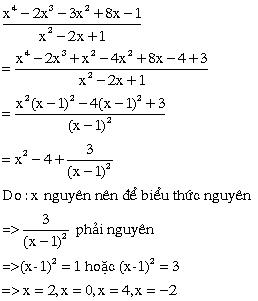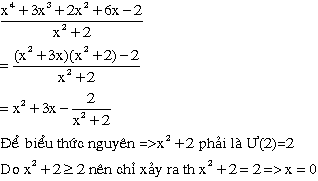
Hãy nhập câu hỏi của bạn vào đây, nếu là tài khoản VIP, bạn sẽ được ưu tiên trả lời.


1.
\(A=\frac{2x^3+x^2+2x+4}{2x+1}=\frac{x^2(2x+1)+(2x+1)+3}{2x+1}=x^2+1+\frac{3}{2x+1}\)
Với $x$ nguyên, để $A$ nguyên thì $3\vdots 2x+1$
$\Rightarrow 2x+1\in \left\{1; -1; 3; -3\right\}$
$\Rightarrow x\in \left\{0; -1; 1; -2\right\}$
2.
\(B=\frac{3x^2-8x+1}{x-3}=\frac{3x(x-3)+x+1}{x-3}=\frac{3x(x-3)+(x-3)+4}{x-3}=3x+1+\frac{4}{x-3}\)
Với $x$ nguyên, để $B$ nguyên thì $4\vdots x-3$
$\Rightarrow x-3\in \left\{\pm 1; \pm 2; \pm 4\right\}$
$\Rightarrow x\in \left\{2; 4; 5; 1; 7; -1\right\}$

MK ko biế đúng ko nữa , sai thì ý kiến
a)

b)

Chúc các bn hok tốt
Tham khảo nhé

a: ĐKXĐ: \(x\notin\left\{-\dfrac{1}{2};\dfrac{1}{2};-2\right\}\)
b: \(B=\dfrac{4x^2+4x+1-4-4x^2+4x-1}{\left(2x-1\right)\left(2x+1\right)}\cdot\dfrac{2x+1}{x+2}\)
\(=\dfrac{8x-4}{2x-1}\cdot\dfrac{1}{x+2}=\dfrac{4}{x+2}\)

\(1.A=x^2+3x-1=-\left(x^2-2.x.\frac{3}{2}+\frac{3}{2}^2-\frac{5}{4}\right)\)
\(A=-\left(x-\frac{3}{2}\right)^2+\frac{5}{4}\)
Vì \(\left(x-\frac{3}{2}\right)^2\ge0,x\in R\)
do đó \(-\left(x-\frac{3}{2}\right)^2\le0,x\in R\)
nên \(-\left(x-\frac{3}{2}\right)^2+\frac{5}{4}\le\frac{5}{4},x\in R\)
Vậy \(Max_A=\frac{5}{4},x=\frac{3}{2}\)

a) ĐKXĐ : x \(\ne-2;x\ne1;x\ne0\)
\(A=\left(\frac{x}{x+2}-\frac{4}{x^2+2x}\right):\left(\frac{x^2-2x+1}{x^2-x}\right)=\left(\frac{x}{x+2}-\frac{4}{x\left(x+2\right)}\right):\left(\frac{\left(x-1\right)^2}{x\left(x-1\right)}\right)\)
\(=\frac{x^2-4}{x\left(x+2\right)}:\frac{x-1}{x}=\frac{\left(x-2\right)\left(x+2\right)}{x\left(x+2\right)}.\frac{x}{x-1}=\frac{x-2}{x}.\frac{x}{x-1}=\frac{x-2}{x-1}\)
b) Để A > 1
=> \(\frac{x-2}{x-1}>1\)
=> \(\frac{x-2}{x-1}-1>0\Rightarrow\frac{-1}{x-1}>0\Rightarrow x-1< 0\Rightarrow x< 1\)
Vậy để A > 1 thì x < 1 và x \(\ne-2;x\ne1;x\ne0\)
c) Ta có \(A=\frac{x-2}{x-1}=\frac{x-1-1}{x-1}=1-\frac{1}{x-1}\)
Để A \(\inℤ\Rightarrow\frac{1}{x-1}\inℤ\Rightarrow1⋮x-1\Rightarrow x-1\inƯ\left(1\right)\Rightarrow x-1\in\left\{1;-1\right\}\)
Khi x - 1 = 1 => x = 2( tm)
Khi x - 1 =-1 => x = 0 (loại)
Vậy x = 2 thì A nguyên
A = \(\dfrac{2x+4}{1-2x}\)
A \(\in\) Z ⇔ 2\(x\) + 4 ⋮ 1 - 2\(x\)
- (1 -2\(x\)) + 5 ⋮ 1 - 2\(x\)
5 ⋮ 1 - 2\(x\)
1 - 2\(x\) \(\in\){ -5; -1; 1; 5}
\(x\) \(\in\) { 3; 1; 0; -2}